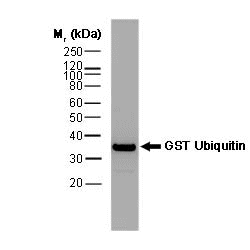GST antibody | vpg66

Mouse anti GST:Biotin
- Product Type
- Monoclonal Antibody
- Clone
- vpg66
- Isotype
- IgG1
- Specificity
- GST
| Mouse anti GST antibody, clone vpg66 reacts with Glutathione-S-transferase |
- Product Form
- Purified IgG conjugated to biotin - liquid
- Preparation
- Antibody purified from tissue culture supernatant
- Buffer Solution
- Phosphate buffered saline
- Preservative Stabilisers
- 0.09% sodium azide (NaN3)
- Immunogen
- GST from Schistosoma japonicum.
- Approx. Protein Concentrations
- IgG concentration 0.1mg/ml
- Fusion Partners
- Spleen cells from immunised BALB/c mice were fused with cells of the mouse NS0 myeloma cell line.
- Regulatory
- For research purposes only
- Guarantee
- 12 months from date of despatch
Avoid repeated freezing and thawing as this may denature the antibody. Storage in frost-free freezers is not recommended.
| Application Name | Verified | Min Dilution | Max Dilution |
|---|---|---|---|
| ELISA | |||
| Western Blotting | 1/100 | 1/500 |
References for GST antibody
-
Harris, M.P. & Neil, J.C. (1994) Myristoylation-dependent binding of HIV-1 Nef to CD4.
J Mol Biol. 241 (2): 136-42. -
Heger, P. et al. (1998) Multimer formation is not essential for nuclear export of human T-cell leukemia virus type 1 Rex trans-activator protein.
J Virol. 72: 8659-68. -
Elfgang, C. et al. (1999) Evidence for specific nucleocytoplasmic transport pathways used by leucine-rich nuclear export signals.
Proc Natl Acad Sci U S A. 96: 6229-34. -
Lischka, P. et al. (2001) A novel transferable nuclear export signal mediates CRM1-independent nucleocytoplasmic shuttling of the human cytomegalovirus transactivator protein pUL69.
EMBO J. 20: 7271-83. -
Davis, M.P. (2008) Recombinant VP4 of human rhinovirus induces permeability in model membranes.
J Virol. 82: 4169-74. -
Shelton, H. & Harris, M. (2008) Hepatitis C virus NS5A protein binds the SH3 domain of the Fyn tyrosine kinase with high affinity: mutagenic analysis of residues within the SH3 domain that contribute to the interaction.
Virol J. 5: 24. -
Foster, T.L. et al. (2011) Cyclophilin A interacts with domain II of hepatitis C virus NS5A and stimulates RNA binding in an isomerase-dependent manner.
J Virol. 85: 7460-4. -
Blüggel, M. et al. (2011) Toward protein biomarkers for allergy: CD4+ T cell proteomics in allergic and nonallergic subjects sampled in and out of pollen season.
J Proteome Res. 10 (4): 1558-70.
View The Latest Product References
- Synonyms
- Glutathione-S-Transferase
- RRID
- AB_322967
MCA1352B
If you cannot find the batch/lot you are looking for please contact our technical support team for assistance.
Please Note: All Products are "FOR RESEARCH PURPOSES ONLY"
Always be the first to know.
When we launch new products and resources to help you achieve more in the lab.
Yes, sign me up